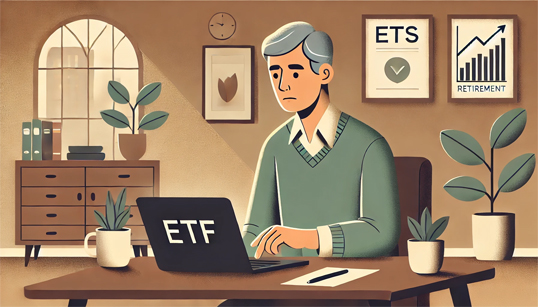Best ETFs for Retirement After 50 (2025 Guide)
For those starting retirement planning in their 50s, exchange-traded funds (ETFs) can offer a low-cost, hands-off way to grow your money. This guide covers the best ETFs for retirement after 50—designed for late starters who want simplicity, safety, and solid returns.
In fact, they might be the perfect starting point for someone looking to invest smartly without complexity.

What Is an ETF, Really?
An ETF (Exchange-Traded Fund) is a type of investment fund that holds a bundle of different assets—like stocks, bonds, or both. Instead of buying individual stocks one by one, an ETF allows you to invest in a diversified portfolio through a single, easy-to-manage investment.
They trade on the stock market just like individual stocks, but they behave more like mutual funds underneath the surface.
✅ Simple
✅ Diversified
✅ Low cost
✅ Easy to start with small amounts
For someone in their 50s who doesn’t want to spend hours researching the stock market, ETFs offer a way to grow wealth without becoming a financial analyst.
Takeaway: ETFs let you invest in a wide mix of assets through one simple product.
Why ETFs Work So Well for Late Starters
Many people over 50 assume that investing now is too risky, too complicated, or simply too late. But ETFs solve several key problems that late starters often face:
- They require little research. You don’t need to pick the “right” stock.
- They’re built for diversification. That lowers your risk.
- They’re affordable. Many ETFs cost less than $100 per share—and you can invest even less through fractional shares.
- They fit well into retirement accounts. You can hold ETFs inside IRAs or 401(k)s easily.
Best of all, ETFs can adapt to your goals—whether that’s steady income, low-risk growth, or just something better than cash sitting in a savings account.
Takeaway: ETFs offer late starters an easy, flexible way to begin investing—even with limited time or experience.
Index Funds vs. ETFs: What’s the Difference?
You might hear “ETF” and “index fund” used almost interchangeably. And that’s fair—they’re very similar. Both typically track a market index (like the S&P 500) and offer broad diversification at low cost.
Here’s the key difference:
| Feature | Index Fund | ETF |
|---|---|---|
| Trades | Once per day | All day (like stocks) |
| Minimum investment | Often $1,000+ | As low as a few dollars |
| Available in IRAs | Yes | Yes |
| Fees | Very low | Very low |
So what’s better for late starters? It depends on your style. If you like the idea of buying and holding, both work. But if you’re starting small or want more flexibility, ETFs may be the more accessible choice.
Takeaway: ETFs work like index funds but are often more flexible and beginner-friendly.
How to Start Using ETFs in Your Retirement Plan
If you’re new to investing in your 50s, here’s a simple roadmap for getting started with ETFs:
- Open a retirement account
- Roth IRA or Traditional IRA are good places to start.
- Many brokerages like Fidelity or Charles Schwab offer free accounts.
- Look for a “total market” or “S&P 500” ETF
- Set up automatic contributions
- Even $100/month adds up.
- Treat it like a bill—non-negotiable and consistent.
- Don’t chase trends
- You don’t need a tech ETF, gold ETF, or crypto ETF.
- Stick to broad, diversified funds unless you know exactly what you’re doing.
Takeaway: A well-chosen ETF inside a retirement account can become the foundation of your late-start investing plan.
Common Questions Late Starters Ask About ETFs
“What if I invest in the wrong ETF?”
Most beginner ETFs track the entire market. If you choose a reputable fund from Vanguard, Schwab, or Fidelity, you’re already well-positioned.
“What if the market crashes?”
Markets go up and down—but historically, they trend upward over time. Late starters benefit most by staying invested consistently.
“Is this better than leaving money in a savings account?”
For long-term goals like retirement, yes. While savings accounts are safe, they often lose value to inflation over time.
Takeaway: Late starters don’t need complex strategies—just clear answers and calm decisions.
Final Thoughts: You Don’t Need to Master ETFs—Just Trust the Simplicity
ETFs can seem like another confusing financial term. But for late starters, they might just be the key to finally getting started with investing—without fear, complexity, or high risk.
You don’t need to become an expert. You don’t need to memorize ticker symbols.
You just need one fund, one account, and one consistent habit.
And with that, your retirement plan has officially begun.
